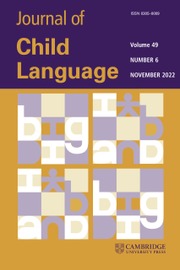Crossref Citations
This article has been cited by the following publications. This list is generated based on data provided by
Crossref.
Barlow, Jessica A.
2001.
Case Study.
Language, Speech, and Hearing Services in Schools,
Vol. 32,
Issue. 4,
p.
242.
Gierut, Judith A.
and
Champion, Annette Hust
2001.
Syllable Onsets II.
Journal of Speech, Language, and Hearing Research,
Vol. 44,
Issue. 4,
p.
886.
Ball, Martin J.
and
Müller, Nicole
2002.
The use of the terms phonetics and phonology in the description of disordered speech.
Advances in Speech Language Pathology,
Vol. 4,
Issue. 2,
p.
95.
YAVAŞ, MEHMET
2003.
Role of sonority in developing phonologies.
Journal of Multilingual Communication Disorders,
Vol. 1,
Issue. 2,
p.
79.
Barlow, Jessica A.
2003.
Asymmetries in the Acquisition of Consonant Clusters in Spanish.
Canadian Journal of Linguistics/Revue canadienne de linguistique,
Vol. 48,
Issue. 3-4,
p.
179.
Barlow, Jessica A.
2005.
Phonological change and the representation of consonant clusters in Spanish: A case study.
Clinical Linguistics & Phonetics,
Vol. 19,
Issue. 8,
p.
659.
Gerrits, Ellen
and
Zumach, Anne
2006.
The acquisition of #sC-clusters in Dutch.
Journal of Multilingual Communication Disorders,
Vol. 4,
Issue. 3,
p.
218.
Morrisette, Michele L.
Farris, Ashley W.
and
Gierut, Judith A.
2006.
Applications of learnability theory to clinical phonology.
Advances in Speech Language Pathology,
Vol. 8,
Issue. 3,
p.
207.
Yavaş, Mehmet
and
Barlow, Jessica A.
2006.
Acquisition of #sC clusters in Spanish-English bilingual children.
Journal of Multilingual Communication Disorders,
Vol. 4,
Issue. 3,
p.
182.
Yavaş, Mehmet
2006.
Sonority and the acquisition of #sC clusters.
Journal of Multilingual Communication Disorders,
Vol. 4,
Issue. 3,
p.
159.
Yavaş, Mehmet
and
Core, Cynthia W.
2006.
Acquisition of #sC clusters in English speaking children.
Journal of Multilingual Communication Disorders,
Vol. 4,
Issue. 3,
p.
169.
Chin, Steven B.
2006.
Realization of complex onsets by pediatric users of cochlear implants.
Clinical Linguistics & Phonetics,
Vol. 20,
Issue. 7-8,
p.
501.
Wyllie‐Smith, Lynelle
McLeod, Sharynne
and
Ball, Martin J.
2006.
Typically developing and speech‐impaired children's adherence to the sonority hypothesis.
Clinical Linguistics & Phonetics,
Vol. 20,
Issue. 4,
p.
271.
Yavaş, Mehmet
and
Beaubrun, Carolyn
2006.
Acquisition of #sC clusters in Haitian Creole-English bilingual children.
Journal of Multilingual Communication Disorders,
Vol. 4,
Issue. 3,
p.
194.
Ben-David, Avivit
2006.
On the acquisition of Hebrew #sC onsets.
Journal of Multilingual Communication Disorders,
Vol. 4,
Issue. 3,
p.
205.
Chin, Steven B.
2007.
Variation in Consonant Cluster Production by Pediatric Cochlear Implant Users.
Ear & Hearing,
Vol. 28,
Issue. 2,
p.
7S.
Barlow, Jessica A.
2007.
Grandfather Effects: A Longitudinal Case Study of the Phonological Acquisition of Intervocalic Consonants in English.
Language Acquisition,
Vol. 14,
Issue. 2,
p.
121.
권보영
2008.
Child reduction of /s/+C onset clusters:/s/ perceived as an unstressed degenerate syllable.
Studies in Phonetics, Phonology, and Morphology,
Vol. 14,
Issue. 1,
p.
3.
Pan, Ning
and
Chen, Liang
2008.
Onset Clusters and Coda-Onset Sequences in Disordered Speech—A Government Phonology Analysis.
Asia Pacific Journal of Speech, Language and Hearing,
Vol. 11,
Issue. 4,
p.
251.
Kim, Jungsun
and
Chin, Steven B.
2008.
Fortition and lenition patterns in the acquisition of obstruents by children with cochlear implants.
Clinical Linguistics & Phonetics,
Vol. 22,
Issue. 3,
p.
233.

